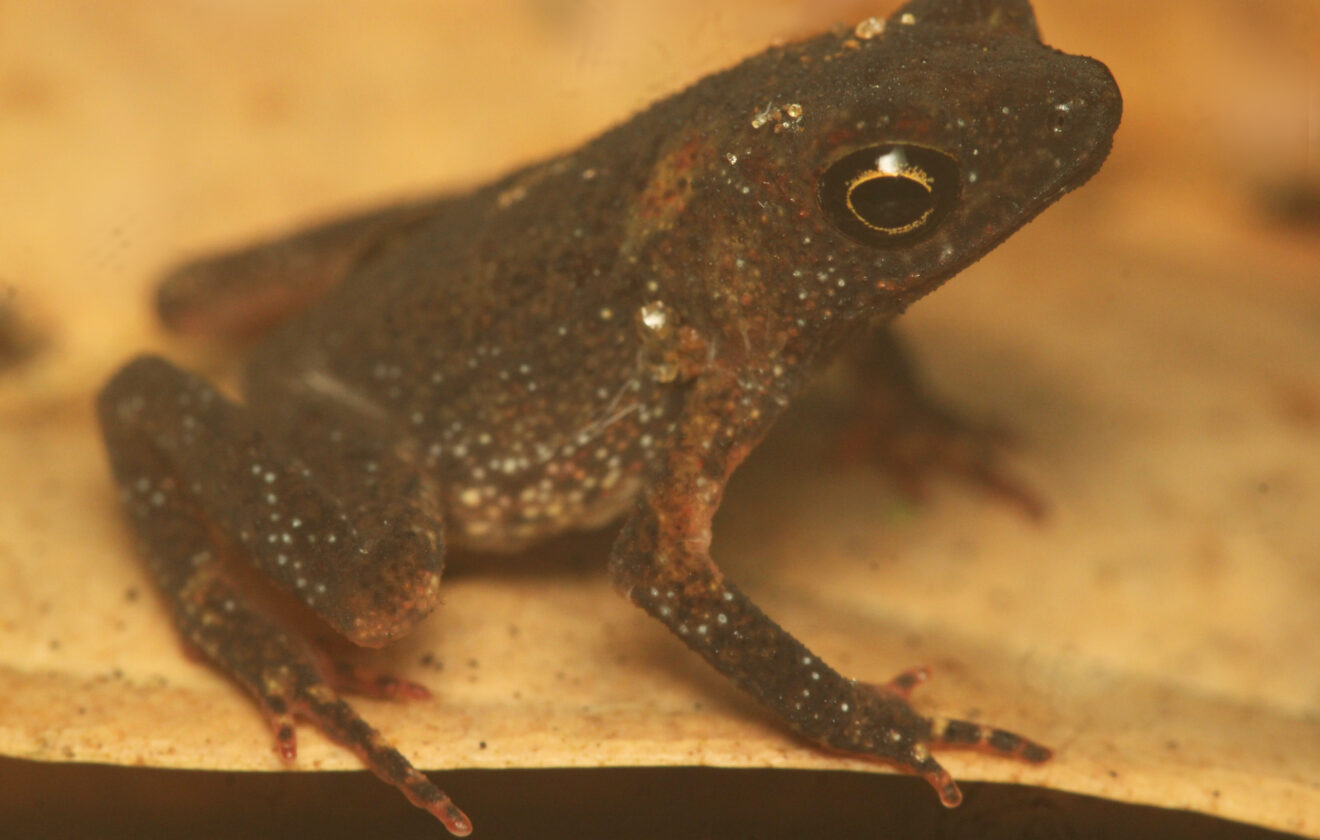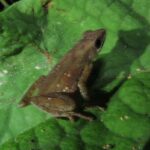- Introduction: Meeting the Amazophrynella teko
- Taxonomy and Classification
- Natural Habitat: The Hidden Niche of <em>Amazophrynella teko</em>
- Physical Characteristics: Master of Camouflage and Subtlety
- Behavior and Life Cycle: Survival and Continuity on the Forest Floor
- The Ecological Role: Small Yet Significant
- Threats & Conservation Status: Preserving the Precious and Ignored
- Cultural and Scientific Significance: Small Frog, Big Lessons
- Conclusion: Protecting Amazophrynella teko and its Rainforest World
Introduction: Meeting the Amazophrynella teko#
In the lush green depths of the Amazon rainforest, hidden amidst fallen leaves and damp soil, resides an extraordinary creature frequently unnoticed even by the most vigilant visitor: Amazophrynella teko. Often regarded simply as another tiny toadlet among the thousands populating the Amazon basin, this species holds its own unique charm. This remarkably small amphibian—rarely much larger than your pinky fingernail—is surprisingly resilient, navigating complexities of rainforest life, survival strategies, and conservation pressures that tell a wider story of biodiversity in an increasingly fragile rainforest ecosystem.
The Amazophrynella teko is notable not only for its minuscule size but for its specialized adaptations to survive in the challenging Amazonian habitat. First described scientifically as recently as 2018, its existence highlights just how much remains unknown about the astonishing diversity hidden in rainforests. Couched in dense vegetation and littered with fallen foliage, their world is finely attuned to providing both camouflage and sustenance. Yet, beneath their inconspicuous behavior and diminutive stature lies a fascinating ecology, physiology, and evolutionary narrative.
Taxonomy and Classification#
The Amazophrynella teko belongs to the Bufonidae family, commonly known as true toads. Within this family, the genus Amazophrynella is impressively diverse, characterized by small-bodied species possessing distinct ecological adaptations for life amidst leaf litter and tropical forest floors.
The species epithet “teko” honors the indigenous Teko people (also known as Emerillon), native inhabitants of the regions where this toadlet thrives. Thanks to dedicated herpetologists and taxonomic researchers exploring remote locations, the literature welcomed this new species into the official scientific canon as recently as 2018, underscoring just how much Earth’s wild places continue to conceal from human eyes.
Closely related species, such as Amazophrynella minuta and Amazophrynella bokermanni, share similar diminutive size and habitat preference, all playing subtle but crucial roles within their ecosystems.
Natural Habitat: The Hidden Niche of Amazophrynella teko#
Amazophrynella teko can be found primarily in the interior tropical forests of French Guiana and northeastern Brazil, regions warmly blanketed by thick vegetation, absorptive soil, and constant humidity. Life among the leaf litter offers protection and a ready source of food in the form of tiny invertebrates—microhabitats that act as miniature forests themselves, perfect for tiny amphibians.
Life Among the Leaf Litter#
Leaf litter ecosystems often go unnoticed, overshadowed by towering trees and lush foliage above. Yet these seemingly trivial carpets of decomposing leaves and fallen fruits are bustling metropolises of insect life, fungi, and microscopic organisms—a veritable feast for small predators like our humble frog. The dense ground cover provides insulation, protection against predators, and moisture retention essential for amphibian survival.
A Reliance on Microhabitats#
The preference for this particular niche offers a glimpse into intricate ecological relationships. In the rainforest understory—a mosaic of shade, moisture, and shelter—Amazophrynella teko survives by embracing these micro-world nuances, demonstrating resilience and adaptability in some of the most biodiverse ecosystems on the planet.
Physical Characteristics: Master of Camouflage and Subtlety#
Rarely exceeding 15 millimeters in length, Amazophrynella teko is truly tiny, able to comfortably sit upon your fingertip. Its small stature, however, reflects substantial adaptive skills rather than vulnerability. It possesses a flattened body optimized for quick movements beneath the dense leaf cover, and its distinctive cryptic coloration, varying from shades of crushed leaves to muddy browns with subtle dark markings, combines to render it practically invisible amidst fallen forest debris.
Adaptations to Survival#
Its skin texture is rugged yet delicate, aiding moisture retention while facilitating necessary respiration through the skin. The limbs are compact and muscular, enabling quick, agile, darting leaps that assist both in hunting prey and evading predators. Functionally perfected for its ecosystem niche, each feature embodies thousands of years of evolution amid the ambient pressures and opportunities presented by rainforest competition and predation.
Behavior and Life Cycle: Survival and Continuity on the Forest Floor#
Though small in scale, the ecological impact of Amazophrynella teko‘s behavior echoes throughout its local ecosystem. Secretive and quiet, they forage primarily at dusk and dawn, capitalizing on twilight’s cooler temperatures and abundant insect prey. Their diet predominantly consists of tiny arthropods—particularly ants and small beetles—demonstrating selective predatory behaviors perfectly adapted to available resources.
Mating and Breeding Rituals#
As rainfall replenishes forest floor pools and streams, these frogs congregate, inspired to begin their delicate reproductive rituals. Male Amazophrynella teko produce calls faint enough that only attentive ears within close proximity might hear them. Their breeding calls, soft chirps reminiscent of crickets, echo subtly through the humidity-laden forests during wet seasons.
Females deposit small clutches of eggs in shallow temporary pools or wet leaf crevices, providing relative safety from aquatic predators found in deeper waters. Tadpoles emerge rapidly, maturing swiftly within these temporary aquatic worlds. Rapidly developing tadpoles face considerable pressure, racing toward metamorphosis before puddles dry out or predators find their hidden nurseries.
Remarkable Defensive Mechanisms#
Despite their small stature, their cryptic coloration combined with quick, unpredictable jumps are efficient defenses. Remarkably, some species in the genus carry mild toxins in the skin as a last line of protection, though research into Amazophrynella teko specifically is still uncovering more about their defensive biology.
The Ecological Role: Small Yet Significant#
Though diminutive, Amazophrynella teko significantly impacts its environment. By consuming insects, it regulates the invertebrate population, contributes to local ecological balance, and acts as prey for larger rainforest inhabitants, such as spiders, snakes, birds, and small mammals. Amphibians are critical indicators—their presence confirms healthy environmental conditions, while declining or absent populations signal ecological distress. Thus, the wellbeing of Amazophrynella teko serves as nature’s subtle indicator of rainforest health.
Threats & Conservation Status: Preserving the Precious and Ignored#
Although recently identified and assessed, Amazophrynella teko faces looming threats synonymous with most Amazonian species: habitat loss, forest fragmentation from logging and mining, pesticide runoff pollution, invasive species pressures, diseases like chytrid fungus, and climate change. Currently categorized as Data Deficient by the IUCN due to limited information, the necessity to study and record more details becomes evident. Essential research, targeted conservation programs, and community engagement remain key strategies needed urgently for survival and protection.
Cultural and Scientific Significance: Small Frog, Big Lessons#
In indigenous Amazonian cultures, frogs and toads occupy special symbolic niches—often associated with rain, fertility, transformation, and rebirth. The indigenous Teko people, after whom this species is named, symbolize a profound relationship between nature and human livelihood, underscoring the interconnectedness of ecological and cultural heritage.
Scientifically, species like Amazophrynella teko drive home the point that even seemingly insignificant organisms offer immense biological, ecological, medical, and pharmaceutical possibilities. Toxins or proteins in amphibian skin can be breakthroughs for medicines, providing solutions for human ailments, infections, and diseases.
Conclusion: Protecting Amazophrynella teko and its Rainforest World#
As our journey through the humble yet extraordinary world of Amazophrynella teko concludes, we understand the delicate dance allowing this miniature marvel to exist. In rediscovering nature’s subtleties, we remind ourselves of the importance of conservation: protecting species unseen by the masses, yet crucial to the integrity of our planet’s complex ecosystems. Let our awe and curiosity inspire voices, resources, and policies toward continued preservation, ensuring that the tiny guardian of the leaf litter endures—safe, thriving, and resonating through the vibrant web of life.















